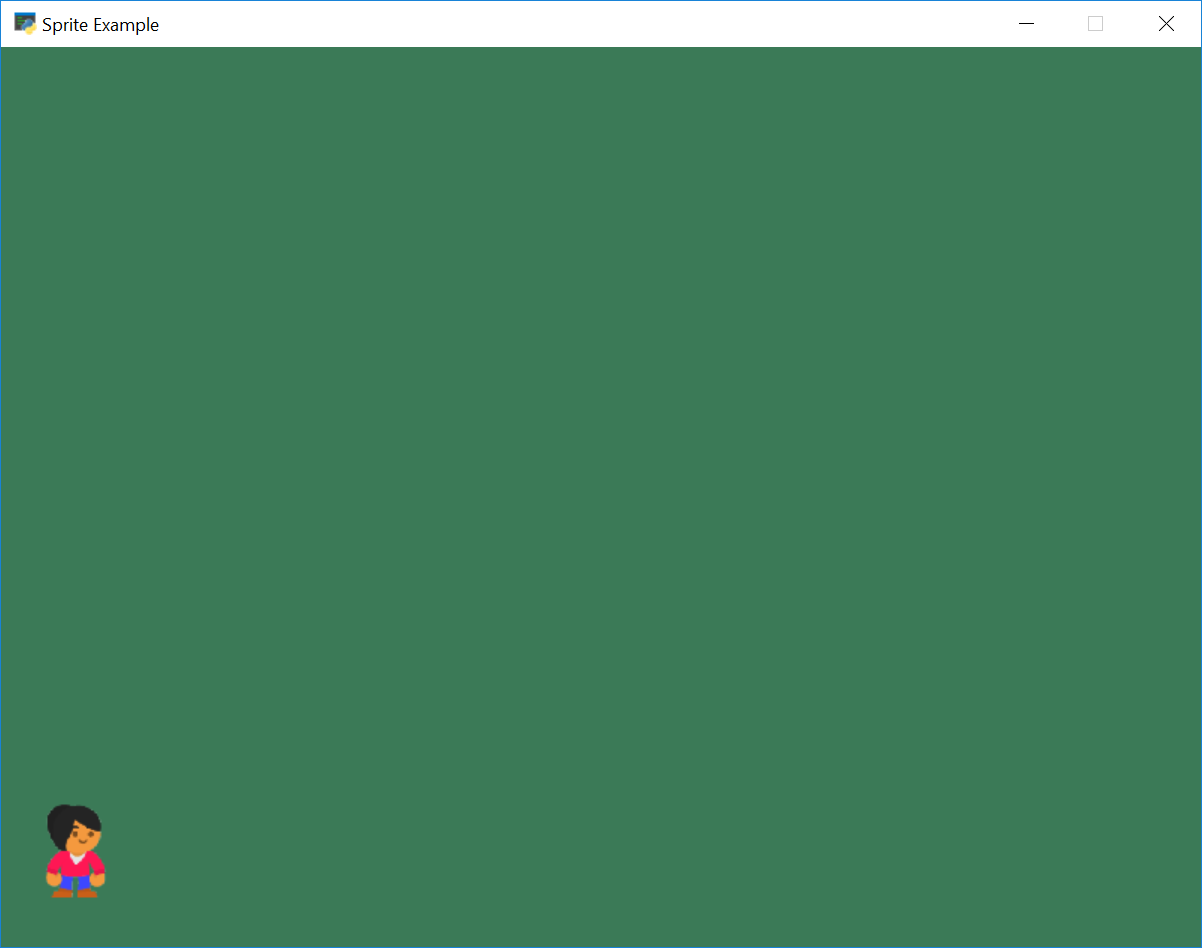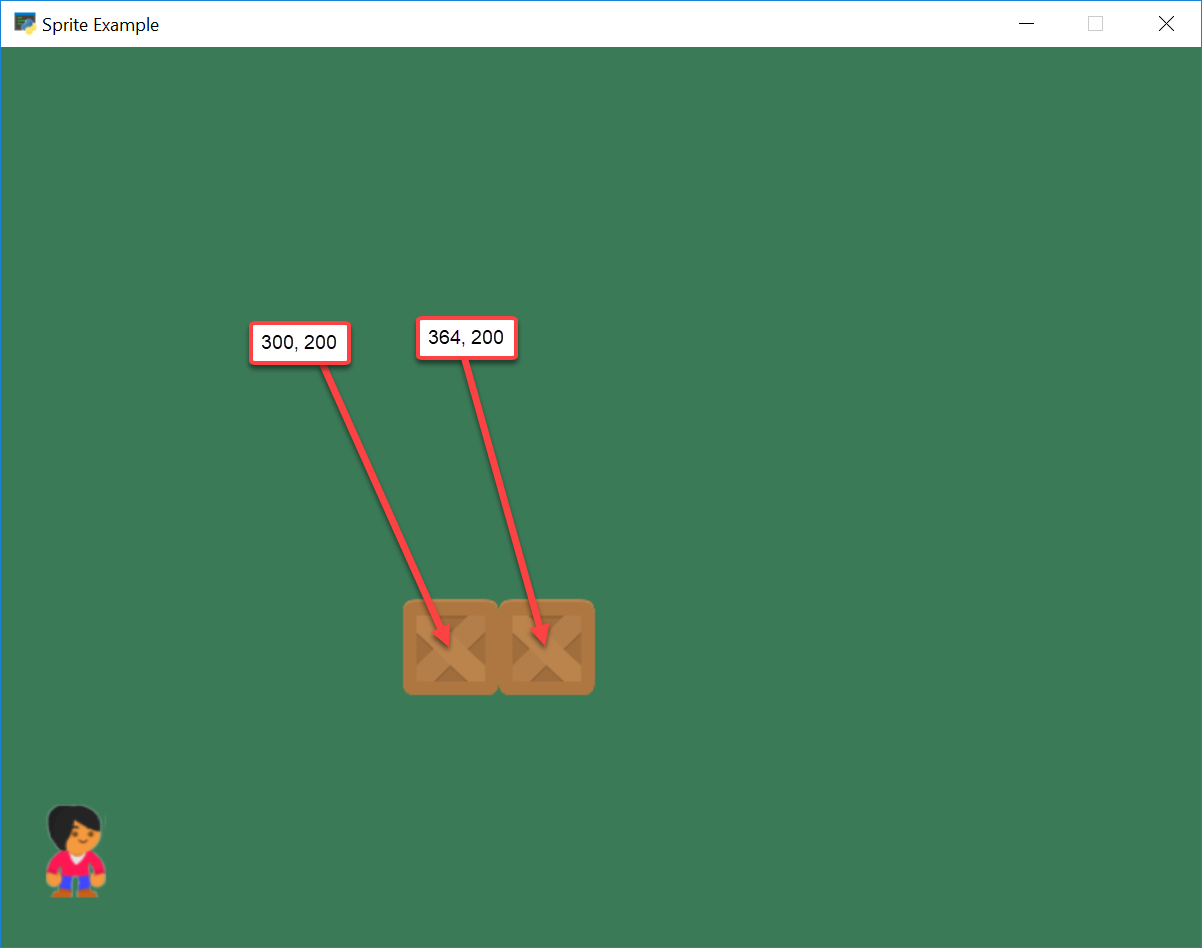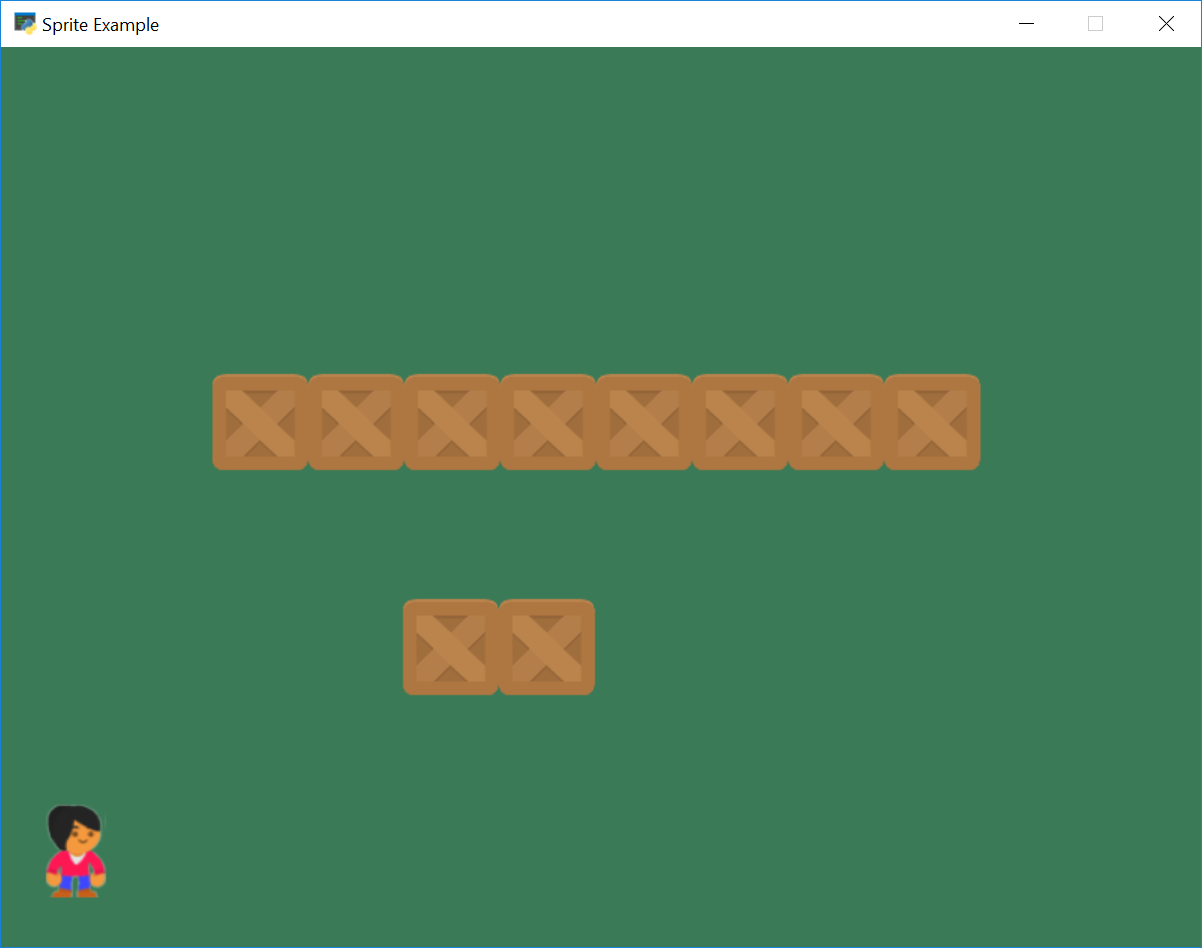25. Sprites and Walls¶
25.1. Setup¶
Many games with sprites often have “walls” that the character can’t move through. There are rather straight-forward to create.
To begin with, let’s get a couple images. Our character, and a box that will act as a blocking wall. Both images are from kenney.nl.

images/character.png¶

images/boxCrate_double.png¶
Start with a default file:
1 2 3 4 5 6 7 8 9 10 11 12 13 14 15 16 17 18 19 20 21 22 23 24 25 26 27 28 29 30 31 32 33 34 35 36 37 38 39 | """ Sprite Sample Program """
import arcade
# --- Constants ---
SPRITE_SCALING_BOX = 0.5
SPRITE_SCALING_PLAYER = 0.5
SCREEN_WIDTH = 800
SCREEN_HEIGHT = 600
MOVEMENT_SPEED = 5
class MyGame(arcade.Window):
""" This class represents the main window of the game. """
def __init__(self):
""" Initializer """
# Call the parent class initializer
super().__init__(SCREEN_WIDTH, SCREEN_HEIGHT, "Sprites With Walls Example")
def setup(self):
# Set the background color
arcade.set_background_color(arcade.color.AMAZON)
def on_draw(self):
arcade.start_render()
def main():
window = MyGame()
window.setup()
arcade.run()
if __name__ == "__main__":
main()
|
In the __init__ method, let’s create some variables to hold our sprites:
# Sprite lists
self.player_list = None
self.wall_list = None
# Set up the player
self.player_sprite = None
# This variable holds our simple "physics engine"
self.physics_engine = None
In the setup method, let’s create our sprite lists:
# Sprite lists
self.player_list = arcade.SpriteList()
self.wall_list = arcade.SpriteList()
Then reset the score and create the player:
# Reset the score
self.score = 0
# Create the player
self.player_sprite = arcade.Sprite("images/character.png", SPRITE_SCALING_PLAYER)
self.player_sprite.center_x = 50
self.player_sprite.center_y = 64
self.player_list.append(self.player_sprite)
Then go ahead and draw everything in our on_draw:
def on_draw(self):
arcade.start_render()
self.wall_list.draw()
self.player_list.draw()
Run the program and make sure it works.

25.2. Individually Placing Walls¶
In our setup method, we can position individual boxes to be used as “walls”:
# Manually create and position a box at 300, 200
wall = arcade.Sprite("images/boxCrate_double.png", SPRITE_SCALING_BOX)
wall.center_x = 300
wall.center_y = 200
self.wall_list.append(wall)
# Manually create and position a box at 364, 200
wall = arcade.Sprite("images/boxCrate_double.png", SPRITE_SCALING_BOX)
wall.center_x = 364
wall.center_y = 200
self.wall_list.append(wall)
Go ahead and try it out. It should look like:

Full listing below:
1 2 3 4 5 6 7 8 9 10 11 12 13 14 15 16 17 18 19 20 21 22 23 24 25 26 27 28 29 30 31 32 33 34 35 36 37 38 39 40 41 42 43 44 45 46 47 48 49 50 51 52 53 54 55 56 57 58 59 60 61 62 63 64 65 66 67 68 69 70 71 72 73 74 | """ Sprite Sample Program """
import arcade
# --- Constants ---
SPRITE_SCALING_BOX = 0.5
SPRITE_SCALING_PLAYER = 0.5
SCREEN_WIDTH = 800
SCREEN_HEIGHT = 600
MOVEMENT_SPEED = 5
class MyGame(arcade.Window):
""" This class represents the main window of the game. """
def __init__(self):
""" Initializer """
# Call the parent class initializer
super().__init__(SCREEN_WIDTH, SCREEN_HEIGHT, "Sprite Example")
# Sprite lists
self.player_list = None
self.wall_list = None
# Set up the player
self.player_sprite = None
def setup(self):
# Set the background color
arcade.set_background_color(arcade.color.AMAZON)
# Sprite lists
self.player_list = arcade.SpriteList()
self.wall_list = arcade.SpriteList()
# Reset the score
self.score = 0
# Create the player
self.player_sprite = arcade.Sprite("images/character.png", SPRITE_SCALING_PLAYER)
self.player_sprite.center_x = 50
self.player_sprite.center_y = 64
self.player_list.append(self.player_sprite)
# Manually create and position a box at 300, 200
wall = arcade.Sprite("images/boxCrate_double.png", SPRITE_SCALING_BOX)
wall.center_x = 300
wall.center_y = 200
self.wall_list.append(wall)
# Manually create and position a box at 364, 200
wall = arcade.Sprite("images/boxCrate_double.png", SPRITE_SCALING_BOX)
wall.center_x = 364
wall.center_y = 200
self.wall_list.append(wall)
def on_draw(self):
arcade.start_render()
self.wall_list.draw()
self.player_list.draw()
def main():
""" Main method """
window = MyGame()
window.setup()
arcade.run()
if __name__ == "__main__":
main()
|
25.3. Placing Walls With A Loop¶
In our setup method, we can create a row of box sprites using a for
loop. In the code below, our y value is always 350, and we change the x value
from 173 to 650. We put a box every 64 pixels because each box happens to be
64 pixels wide.
# Place boxes inside a loop
for x in range(173, 650, 64):
wall = arcade.Sprite("images/boxCrate_double.png", SPRITE_SCALING_BOX)
wall.center_x = x
wall.center_y = 350
self.wall_list.append(wall)

25.4. Placing Walls With A List¶
You could even create a list of coordinates, and then just loop through that list creating walls:
# --- Place walls with a list
coordinate_list = [[400, 500],
[470, 500],
[400, 570],
[470, 570]]
# Loop through coordinates
for coordinate in coordinate_list:
wall = arcade.Sprite("images/boxCrate_double.png", SPRITE_SCALING_BOX)
wall.center_x = coordinate[0]
wall.center_y = coordinate[1]
self.wall_list.append(wall)

Full listing below:
1 2 3 4 5 6 7 8 9 10 11 12 13 14 15 16 17 18 19 20 21 22 23 24 25 26 27 28 29 30 31 32 33 34 35 36 37 38 39 40 41 42 43 44 45 46 47 48 49 50 51 52 53 54 55 56 57 58 59 60 61 62 63 64 65 66 67 68 69 70 71 72 73 74 75 76 77 78 79 80 81 82 83 84 85 86 87 88 89 90 91 92 93 94 95 96 | """ Sprite Sample Program """
import arcade
# --- Constants ---
SPRITE_SCALING_BOX = 0.5
SPRITE_SCALING_PLAYER = 0.5
SCREEN_WIDTH = 800
SCREEN_HEIGHT = 600
MOVEMENT_SPEED = 5
class MyGame(arcade.Window):
""" This class represents the main window of the game. """
def __init__(self):
""" Initializer """
# Call the parent class initializer
super().__init__(SCREEN_WIDTH, SCREEN_HEIGHT, "Sprite Example")
# Sprite lists
self.player_list = None
self.wall_list = None
# Set up the player
self.player_sprite = None
def setup(self):
# Set the background color
arcade.set_background_color(arcade.color.AMAZON)
# Sprite lists
self.player_list = arcade.SpriteList()
self.wall_list = arcade.SpriteList()
# Reset the score
self.score = 0
# Create the player
self.player_sprite = arcade.Sprite("images/character.png", SPRITE_SCALING_PLAYER)
self.player_sprite.center_x = 50
self.player_sprite.center_y = 64
self.player_list.append(self.player_sprite)
# --- Manually place walls
# Manually create and position a box at 300, 200
wall = arcade.Sprite("images/boxCrate_double.png", SPRITE_SCALING_BOX)
wall.center_x = 300
wall.center_y = 200
self.wall_list.append(wall)
# Manually create and position a box at 364, 200
wall = arcade.Sprite("images/boxCrate_double.png", SPRITE_SCALING_BOX)
wall.center_x = 364
wall.center_y = 200
self.wall_list.append(wall)
# --- Place boxes inside a loop
for x in range(173, 650, 64):
wall = arcade.Sprite("images/boxCrate_double.png", SPRITE_SCALING_BOX)
wall.center_x = x
wall.center_y = 350
self.wall_list.append(wall)
# --- Place walls with a list
coordinate_list = [[400, 500],
[470, 500],
[400, 570],
[470, 570]]
# Loop through coordinates
for coordinate in coordinate_list:
wall = arcade.Sprite("images/boxCrate_double.png", SPRITE_SCALING_BOX)
wall.center_x = coordinate[0]
wall.center_y = coordinate[1]
self.wall_list.append(wall)
def on_draw(self):
arcade.start_render()
self.player_list.draw()
self.wall_list.draw()
def main():
""" Main method """
window = MyGame()
window.setup()
arcade.run()
if __name__ == "__main__":
main()
|
25.5. Physics Engine¶
First, we need to hook the keyboard up to the player:
def on_key_press(self, key, modifiers):
"""Called whenever a key is pressed. """
if key == arcade.key.UP:
self.player_sprite.change_y = MOVEMENT_SPEED
elif key == arcade.key.DOWN:
self.player_sprite.change_y = -MOVEMENT_SPEED
elif key == arcade.key.LEFT:
self.player_sprite.change_x = -MOVEMENT_SPEED
elif key == arcade.key.RIGHT:
self.player_sprite.change_x = MOVEMENT_SPEED
def on_key_release(self, key, modifiers):
"""Called when the user releases a key. """
if key == arcade.key.UP or key == arcade.key.DOWN:
self.player_sprite.change_y = 0
elif key == arcade.key.LEFT or key == arcade.key.RIGHT:
self.player_sprite.change_x = 0
Now, we need to add a way to stop the player from running into walls.
The Arcade Library has a built in “physics engine.” A physics engine handles the interactions between the virtual physical objects in the game. For example, a physics engine might be several balls running into each other, a character sliding down a hill, or a car making a turn on the road.
Physics engines have made impressive gains on what they can simulate. For our game, we’ll just keep things simple and make sure our character can’t walk through walls.
We’ll create variable to hold our physics engine in the __init__:
# This variable holds our simple "physics engine"
self.physics_engine = None
We can create the actual physics engine in our setup method with the following
code:
self.physics_engine = arcade.PhysicsEngineSimple(self.player_sprite, self.wall_list)
This identifies the player character (player_sprite), and a list of sprites
(wall_list) that the player character isn’t allowed to pass through.
Before, we updated all the sprites with a self.all_sprites_list.update()
command. With the physics engine, we will instead update the sprites by using
the physics engine’s update:
def update(self, delta_time):
self.physics_engine.update()
The simple physics engine follows the following algorithm:
Move the player in the x direction according to the player’s
change_xvalue.Check the player against the wall list and see if there are any collisions.
If the player is colliding:
If the player is moving right, set the player’s right edge to the wall’s left edge.
If the player is moving left, set the player’s left edge to the wall’s right edge.
If the player isn’t moving left or right, print out a message that we are confused how we hit something when we aren’t moving.
Then we just do the same thing, except with the y coordinates.
You can see the physics engine source code on GitHub.
Here’s the full example:
1 2 3 4 5 6 7 8 9 10 11 12 13 14 15 16 17 18 19 20 21 22 23 24 25 26 27 28 29 30 31 32 33 34 35 36 37 38 39 40 41 42 43 44 45 46 47 48 49 50 51 52 53 54 55 56 57 58 59 60 61 62 63 64 65 66 67 68 69 70 71 72 73 74 75 76 77 78 79 80 81 82 83 84 85 86 87 88 89 90 91 92 93 94 95 96 97 98 99 100 101 102 103 104 105 106 107 108 109 110 111 112 113 114 115 116 117 118 119 120 121 122 123 124 125 126 | """ Sprite Sample Program """
import arcade
# --- Constants ---
SPRITE_SCALING_BOX = 0.5
SPRITE_SCALING_PLAYER = 0.5
SCREEN_WIDTH = 800
SCREEN_HEIGHT = 600
MOVEMENT_SPEED = 5
class MyGame(arcade.Window):
""" This class represents the main window of the game. """
def __init__(self):
""" Initializer """
# Call the parent class initializer
super().__init__(SCREEN_WIDTH, SCREEN_HEIGHT, "Sprite Example")
# Sprite lists
self.player_list = None
self.wall_list = None
# Set up the player
self.player_sprite = None
# This variable holds our simple "physics engine"
self.physics_engine = None
def setup(self):
# Set the background color
arcade.set_background_color(arcade.color.AMAZON)
# Sprite lists
self.player_list = arcade.SpriteList()
self.wall_list = arcade.SpriteList()
# Reset the score
self.score = 0
# Create the player
self.player_sprite = arcade.Sprite("images/character.png", SPRITE_SCALING_PLAYER)
self.player_sprite.center_x = 50
self.player_sprite.center_y = 64
self.player_list.append(self.player_sprite)
# --- Manually place walls
# Manually create and position a box at 300, 200
wall = arcade.Sprite("images/boxCrate_double.png", SPRITE_SCALING_BOX)
wall.center_x = 300
wall.center_y = 200
self.wall_list.append(wall)
# Manually create and position a box at 364, 200
wall = arcade.Sprite("images/boxCrate_double.png", SPRITE_SCALING_BOX)
wall.center_x = 364
wall.center_y = 200
self.wall_list.append(wall)
# --- Place boxes inside a loop
for x in range(173, 650, 64):
wall = arcade.Sprite("images/boxCrate_double.png", SPRITE_SCALING_BOX)
wall.center_x = x
wall.center_y = 350
self.wall_list.append(wall)
# --- Place walls with a list
coordinate_list = [[400, 500],
[470, 500],
[400, 570],
[470, 570]]
# Loop through coordinates
for coordinate in coordinate_list:
wall = arcade.Sprite("images/boxCrate_double.png", SPRITE_SCALING_BOX)
wall.center_x = coordinate[0]
wall.center_y = coordinate[1]
self.wall_list.append(wall)
# Create the physics engine. Give it a reference to the player, and
# the walls we can't run into.
self.physics_engine = arcade.PhysicsEngineSimple(self.player_sprite, self.wall_list)
def on_draw(self):
arcade.start_render()
self.wall_list.draw()
self.player_list.draw()
def update(self, delta_time):
self.physics_engine.update()
def on_key_press(self, key, modifiers):
"""Called whenever a key is pressed. """
if key == arcade.key.UP:
self.player_sprite.change_y = MOVEMENT_SPEED
elif key == arcade.key.DOWN:
self.player_sprite.change_y = -MOVEMENT_SPEED
elif key == arcade.key.LEFT:
self.player_sprite.change_x = -MOVEMENT_SPEED
elif key == arcade.key.RIGHT:
self.player_sprite.change_x = MOVEMENT_SPEED
def on_key_release(self, key, modifiers):
"""Called when the user releases a key. """
if key == arcade.key.UP or key == arcade.key.DOWN:
self.player_sprite.change_y = 0
elif key == arcade.key.LEFT or key == arcade.key.RIGHT:
self.player_sprite.change_x = 0
def main():
""" Main method """
window = MyGame()
window.setup()
arcade.run()
if __name__ == "__main__":
main()
|
25.6. Using a View Port for Scrolling¶
What if one screen isn’t enough to hold your maze of walls? We can have a world that is larger than just our window. We do this by adjusting the view port. Normally coordinate (0, 0) is the lower left corner of our screen. We can change that! We could have an entire world stretch from (0, 0) to (3000, 3000), and have a smaller view port that was 800x640 that scrolled around that.
The command for using the view port is set_viewport. This command takes
four arguments. The first two are the left and bottom boundaries of the window.
By default these are zero. That is why (0, 0) is in the lower left of the
screen. The next two commands are the top and right coordinates of the screen.
By default these are the screen width and height, minus one. So an 800
pixel-wide window would have x-coordinates from 0 - 799.
A command like this would shift the whole “view” of the window 200 pixels to the right:
# Specify viewport size by (left, right, bottom, top)
arcade.set_viewport(200, 200 + SCREEN_WIDTH - 1, 0, SCREEN_HEIGHT - 1)
So with a 800 wide pixel window, we would show x-coordinates 200 - 999 instead of 0 - 799.
Instead of hard-coding the shift at 200 pixels, we need to use a variable and have rules around when to shift the view. In our next example, we will create two new instance variables in our application class that hold the left and bottom coordinates for our view port. We’ll default to zero.
self.view_left = 0
self.view_bottom = 0
We are also going to create two new constants. We don’t want the player to reach the edge of the screen before we start scrolling. Because then the player would have no idea where she is going. In our example we will set a “margin” of 150 pixels. When the player is 150 pixels from the edge of the screen, we’ll move the view port so she can see at least 150 pixels around her.
VIEWPORT_MARGIN = 150
Next, in our update method, we need to see if the user has moved too close to the edge of the screen and we need to update the boundaries.
# Keep track of if we changed the boundary. We don't want to call the
# set_viewport command if we didn't change the view port.
changed = False
# Scroll left
left_boundary = self.view_left + VIEWPORT_MARGIN
if self.player_sprite.left < left_boundary:
self.view_left -= left_boundary - self.player_sprite.left
changed = True
# Scroll right
right_boundary = self.view_left + SCREEN_WIDTH - VIEWPORT_MARGIN
if self.player_sprite.right > right_boundary:
self.view_left += self.player_sprite.right - right_boundary
changed = True
# Scroll up
top_boundary = self.view_bottom + SCREEN_HEIGHT - VIEWPORT_MARGIN
if self.player_sprite.top > top_boundary:
self.view_bottom += self.player_sprite.top - top_boundary
changed = True
# Scroll down
bottom_boundary = self.view_bottom + VIEWPORT_MARGIN
if self.player_sprite.bottom < bottom_boundary:
self.view_bottom -= bottom_boundary - self.player_sprite.bottom
changed = True
# Make sure our boundaries are integer values. While the view port does
# support floating point numbers, for this application we want every pixel
# in the view port to map directly onto a pixel on the screen. We don't want
# any rounding errors.
self.view_left = int(self.view_left)
self.view_bottom = int(self.view_bottom)
# If we changed the boundary values, update the view port to match
if changed:
arcade.set_viewport(self.view_left,
SCREEN_WIDTH + self.view_left - 1,
self.view_bottom,
SCREEN_HEIGHT + self.view_bottom - 1)
The full example is below:
1 2 3 4 5 6 7 8 9 10 11 12 13 14 15 16 17 18 19 20 21 22 23 24 25 26 27 28 29 30 31 32 33 34 35 36 37 38 39 40 41 42 43 44 45 46 47 48 49 50 51 52 53 54 55 56 57 58 59 60 61 62 63 64 65 66 67 68 69 70 71 72 73 74 75 76 77 78 79 80 81 82 83 84 85 86 87 88 89 90 91 92 93 94 95 96 97 98 99 100 101 102 103 104 105 106 107 108 109 110 111 112 113 114 115 116 117 118 119 120 121 122 123 124 125 126 127 128 129 130 131 132 133 134 135 136 137 138 139 140 141 142 143 144 145 146 147 148 149 150 151 152 153 154 155 156 157 158 159 160 161 162 163 164 165 166 167 168 169 170 171 172 173 174 175 176 177 178 179 180 | """ Sprite Sample Program """
import arcade
# --- Constants ---
SPRITE_SCALING_BOX = 0.5
SPRITE_SCALING_PLAYER = 0.5
SCREEN_WIDTH = 800
SCREEN_HEIGHT = 600
MOVEMENT_SPEED = 5
VIEWPORT_MARGIN = 150
class MyGame(arcade.Window):
""" This class represents the main window of the game. """
def __init__(self):
""" Initializer """
# Call the parent class initializer
super().__init__(SCREEN_WIDTH, SCREEN_HEIGHT, "Sprite Example")
# Sprite lists
self.player_list = None
self.wall_list = None
# Set up the player
self.player_sprite = None
# This variable holds our simple "physics engine"
self.physics_engine = None
# Manage the view port
self.view_left = 0
self.view_bottom = 0
def setup(self):
# Set the background color
arcade.set_background_color(arcade.color.AMAZON)
# Reset the view port
self.view_left = 0
self.view_bottom = 0
# Sprite lists
self.player_list = arcade.SpriteList()
self.wall_list = arcade.SpriteList()
# Reset the score
self.score = 0
# Create the player
self.player_sprite = arcade.Sprite("images/character.png", SPRITE_SCALING_PLAYER)
self.player_sprite.center_x = 50
self.player_sprite.center_y = 64
self.player_list.append(self.player_sprite)
# --- Manually place walls
# Manually create and position a box at 300, 200
wall = arcade.Sprite("images/boxCrate_double.png", SPRITE_SCALING_BOX)
wall.center_x = 300
wall.center_y = 200
self.wall_list.append(wall)
# Manually create and position a box at 364, 200
wall = arcade.Sprite("images/boxCrate_double.png", SPRITE_SCALING_BOX)
wall.center_x = 364
wall.center_y = 200
self.wall_list.append(wall)
# --- Place boxes inside a loop
for x in range(173, 650, 64):
wall = arcade.Sprite("images/boxCrate_double.png", SPRITE_SCALING_BOX)
wall.center_x = x
wall.center_y = 350
self.wall_list.append(wall)
# --- Place walls with a list
coordinate_list = [[400, 500],
[470, 500],
[400, 570],
[470, 570]]
# Loop through coordinates
for coordinate in coordinate_list:
wall = arcade.Sprite("images/boxCrate_double.png", SPRITE_SCALING_BOX)
wall.center_x = coordinate[0]
wall.center_y = coordinate[1]
self.wall_list.append(wall)
# Create the physics engine. Give it a reference to the player, and
# the walls we can't run into.
self.physics_engine = arcade.PhysicsEngineSimple(self.player_sprite, self.wall_list)
def on_draw(self):
arcade.start_render()
self.wall_list.draw()
self.player_list.draw()
def update(self, delta_time):
self.physics_engine.update()
# --- Manage Scrolling ---
# Keep track of if we changed the boundary. We don't want to call the
# set_viewport command if we didn't change the view port.
changed = False
# Scroll left
left_boundary = self.view_left + VIEWPORT_MARGIN
if self.player_sprite.left < left_boundary:
self.view_left -= left_boundary - self.player_sprite.left
changed = True
# Scroll right
right_boundary = self.view_left + SCREEN_WIDTH - VIEWPORT_MARGIN
if self.player_sprite.right > right_boundary:
self.view_left += self.player_sprite.right - right_boundary
changed = True
# Scroll up
top_boundary = self.view_bottom + SCREEN_HEIGHT - VIEWPORT_MARGIN
if self.player_sprite.top > top_boundary:
self.view_bottom += self.player_sprite.top - top_boundary
changed = True
# Scroll down
bottom_boundary = self.view_bottom + VIEWPORT_MARGIN
if self.player_sprite.bottom < bottom_boundary:
self.view_bottom -= bottom_boundary - self.player_sprite.bottom
changed = True
# Make sure our boundaries are integer values. While the view port does
# support floating point numbers, for this application we want every pixel
# in the view port to map directly onto a pixel on the screen. We don't want
# any rounding errors.
self.view_left = int(self.view_left)
self.view_bottom = int(self.view_bottom)
# If we changed the boundary values, update the view port to match
if changed:
arcade.set_viewport(self.view_left,
SCREEN_WIDTH + self.view_left - 1,
self.view_bottom,
SCREEN_HEIGHT + self.view_bottom - 1)
def on_key_press(self, key, modifiers):
""" Called whenever a key is pressed. """
if key == arcade.key.UP:
self.player_sprite.change_y = MOVEMENT_SPEED
elif key == arcade.key.DOWN:
self.player_sprite.change_y = -MOVEMENT_SPEED
elif key == arcade.key.LEFT:
self.player_sprite.change_x = -MOVEMENT_SPEED
elif key == arcade.key.RIGHT:
self.player_sprite.change_x = MOVEMENT_SPEED
def on_key_release(self, key, modifiers):
"""Called when the user releases a key. """
if key == arcade.key.UP or key == arcade.key.DOWN:
self.player_sprite.change_y = 0
elif key == arcade.key.LEFT or key == arcade.key.RIGHT:
self.player_sprite.change_x = 0
def main():
""" Main method """
window = MyGame()
window.setup()
arcade.run()
if __name__ == "__main__":
main()
|